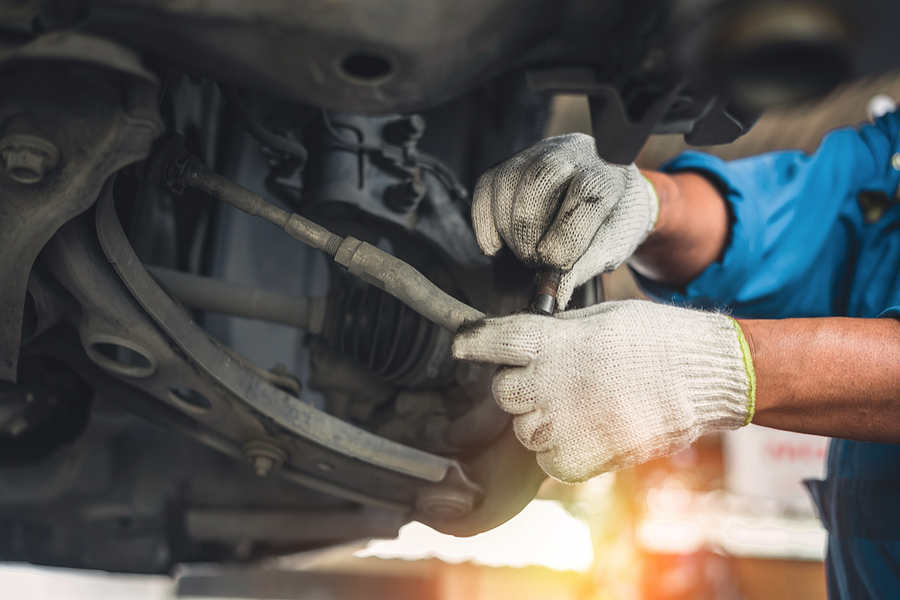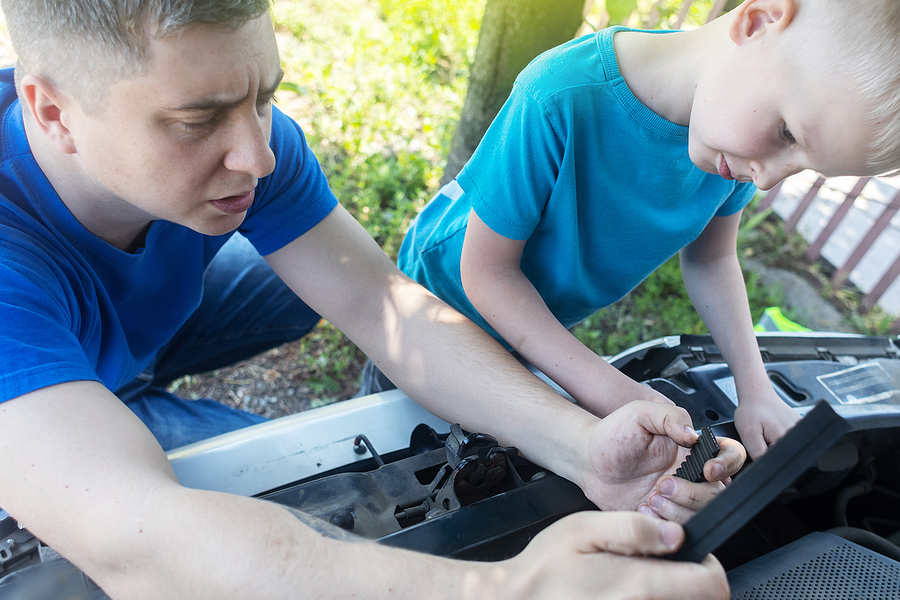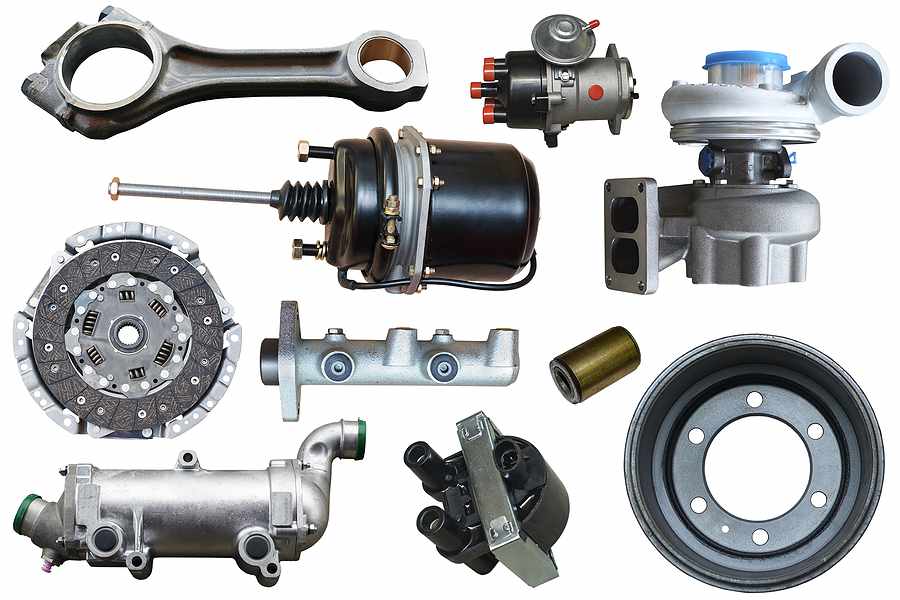
by Admin | Jun 5, 2023 | Auto Care Blog
For superstars and the super-rich, cars are more than a form of transportation. They are a status symbol as well. Collecting cars has long been a hobby for celebrities to show off their taste and wealth.
Batmobile and the DeLorean
In Hollywood, the Batmobile is the getaway car for the caped crusader, and we love to see it.
The Batmobile has been reinvented many times, with each version having its unique features. But the original 1966 version that was owned by Adam West is perhaps the most famous, and it’s no surprise it’s been a part of many car collections over the years.
There’s also the DeLorean, a car that gained fame thanks to its appearance in the 1985 film, Back to the Future. Doc Brown’s Delorean DMC-12 has a sleek, stainless steel exterior and gull-wing doors. Its unique, retro-futurism design has made it a favorite among car enthusiasts and collectors.

A 1981 Delorean DMC 12 on display at the 2018 International Auto Show at the Miami Beach Convention Center . Photographed on 13 October 2018.
The famous comedian and car collector Jay Leno is known for his deep-seated penchant for unusual vehicles. And he has a stash of green Benjamins to splurge on the four-wheelers! Leno’s eclectic car collections include a jet-powered motorcycle and a steam-powered car. But his longest-owned acquisition is a 955 Buick Roadmaster.
Meanwhile, rapper Nicki Minaj has a $450,000 bright pink Lamborghini Aventador that turns heads wherever she goes. She acquired the Aventador in 2010 after her first Solo Album.
Customization to stand out
Some celebrities have taken customization to the next level by adding unique features to their rides. The standard features just don’t offer enough street cred to stand out for some celebrities!
For example, Justin Bieber’s Fisker Karma has been wrapped in chrome, while David Beckham’s Rolls Royce Phantom features a custom paint job that pays tribute to his love of tattoos.
Indeed, the rich and the famous have the means to express the entrenched love of every one of the car enthusiasts. And don’t we love to see it?

by Admin | Apr 20, 2023 | Auto Care Blog, Suspension
Our repair shop has seen countless vehicles come into the shop with suspension issues. Interestingly, most of these issues could’ve been prevented with little knowledge.
Your car’s suspension system carries the bulk of keeping you comfortable and safe on the road. It’s that important! It, therefore, makes sense to understand how it works and when to see a professional mechanic have it checked.
What Does Your Suspension System Do?
Your suspension system hosts various components that collaborate to keep the car’s wheels in contact with the road. The most important parts include control arms, springs, struts, and shocks.
The suspension system also dampens the effect of bumps, potholes, and other imperfections on the road. This ensures that you can enjoy a smoother ride.
When Should You Get Your Suspension System Checked?
Like every other part of your vehicle, your suspension will succumb to the forces of wear and tear. So, how do you tell if the suspension is due for repair or replacement?
We often tell our clients to watch out for the following:
- Uneven tire wear
- Difficulty steering or handling
- Your vehicle yanks to one side while driving
- A bumpy or rough ride
- Clunking or squeaking noises when driving over bumps
Any of these symptoms tell you that the suspension is not okay and could do with some professional check. Reach out to A1 Performance Autorepair, and we’ll thoroughly assess your suspension. That’s what we do!
We often advise regular suspension system maintenance to prevent repairs that may cost you an arm and a leg. Bring your vehicle for periodic suspension checks, and we’ll be able to catch any problems early to prevent further damage.

by Admin | Apr 5, 2023 | Auto Care Blog
A1 Performance Autorepair mechanics have seen a fair share of botched DIY car repairs. It’s the ‘YouTube videos that made them do it,’ they always say. While it’s good to learn a few tips to maintain your vehicle in top condition, some things are best left to professionals.
So, what can and cannot be done by yourself regarding auto repairs?
What You Can Do Yourself:
- Change your oil: Changing your oil is a relatively straightforward process that can save you a few bucks. Just follow your car manufacturer’s recommendations on oil type and frequency of changes.
- Replace wiper blades: If your wiper blades are leaving streaks or not clearing your windshield properly, it’s time for a replacement. This is a quick and easy fix that anyone can do.
- Replace air filters: Your engine needs air to breathe, and a dirty air filter can reduce performance and fuel efficiency. Replacing your air filter is a simple task that can save bucks in the long run.
- Replace headlights and taillights: Burned-out headlights and taillights can be a safety hazard and earn you a ticket. Replacing them is a straightforward task that doesn’t require any special tools.
What You Should Leave to the Pros:
- Electrical work: Unless you’re a trained electrician, it’s best to leave any electrical work to the professionals. One wrong move could cause serious damage to your car’s electrical system.
- Brake repairs: Your brakes are your car’s most important safety feature. If you’re not confident in your ability to replace brake pads or rotors, it’s best to let a professional handle it.
- Transmission repairs: Your car’s transmission is a complex and delicate system requiring specialized tools and knowledge. Attempting to fix it yourself could cost you more in the long run.
- Suspension repairs: Your car’s suspension system keeps you comfortable and safe on the road. Attempting to fix it yourself could result in a bumpy and dangerous ride.
A rule of thumb: When in doubt, it’s always best to consult with A1 Performance Autorepair mechanics.

by Admin | Mar 20, 2023 | Auto Care Blog
Your beloved sedan or truck needs some tender love and care so that it treats you well on the road and in your pocket.
But no matter how well you follow the maintenance schedules and care tips, your car will eventually need new parts. So, do you go for the OEM (original equipment manufacturer) parts or aftermarket parts?
Both types of spare parts will get the job done, but there are key benefits to choosing original parts.
Why You Should Choose Original Parts for Your Vehicle
- Perfect fit: OEM parts are from the same manufacturer that made your car, which means they’re the perfect fit. These parts are like the perfect shoe that fits, so the likelihood of problems down the road is slim.
- Made from high-quality materials: OEM parts are built to serve you longer, and that means the replacements are few and far between. The original parts may have a higher price tag, but they recoup the investment in the long run.
- Backed by a warranty: the manufacturer will always back the OEM parts with a warranty. This shows confidence in the quality of their products. On the other hand, most aftermarket parts may not have a warranty, so you’re on your own should something unexpected happen.
- Resale value: car buyers prefer a used car maintained with OEM parts because it’s the clearest indication of longevity.
Undoubtedly, aftermarket parts will save a few bucks and may be a good choice in the long term. However, OEM parts last longer, work well, and save you from headaches. Original parts keep the vehicle running for longer and maintain its value. You get what you pay for.
At A1 Performance Auto Repair, we use original parts when fixing your vehicle. This is because our focus is quality services to keep your car on the road for longer and be productive. Contact us today in case you’re having issues with your vehicle.

by Admin | Feb 5, 2023 | Auto Care Blog, Ford
We can say that the American market keeps fresh and bubbly inside the transit cargo vans. You see, transit vans have been the proverbial mules that haul all the stuff of enterprises from one store to the other or from the store to the client’s premises – you get the idea.
The Ford Transit Cargo Van has been a go-to for contractors, delivery drivers, and anyone who has needed a versatile and reliable ride for years. But why is it the trusty Ford Transit Cargo Van?
Versatility
The Ford Transit Cargo Van ticks the boxes to handle any situation you throw at it.
The van comes in three different body lengths, two wheelbases, and three roof heights to pick the perfect configuration for your needs. This comes in handy whether you’re hauling a ton of stuff or need a compact ride for tight city streets.
Comfort
Don’t let the fact that it’s a workhorse fool you – the Transit Cargo Van is quite comfortable to drive. Its suspension and weight distribution provide a smooth ride, and the seats are supportive and comfortable. The cabin is spacious, so you can stretch out and work comfortably for as long as needed.
Fuel Efficiency
Someone said you could not use the term fuel efficiency and a workhorse in the same sentence when describing a transit van. But they probably never met the Ford Transit cargo van.
Who says you can’t have your cake and eat it too? The Transit Cargo Van offers a range of engines, including a fuel-efficient diesel option. You can therefore choose the one that best meets your needs and budget. And no matter your engine, you’ll still get excellent fuel economy and save money at the pump.
Load Capacity
What is a transit van with an insufficient load capacity? Something else, but not a transit van. That’s for sure!
The Ford Transit Cargo Van is like a pack mule – it can haul a ton of stuff! With a payload of up to 4,650 pounds, the van is perfect for contractors, delivery drivers, or anyone who needs to transport a lot of heavy items. So go ahead and load it up – the Transit can handle it!
Technology
Gone are the days of groping with a map and a calculator to figure out your route. The Transit Cargo Van comes equipped with a touchscreen infotainment system with connectivity for Android Auto and Apple CarPlay. You can easily navigate, make calls, and listen to music. And with available features like a rearview camera, parking sensors, and a 360-degree camera system, you’ll have all the help you need to stay safe on the road.
Safety
Safety is no joke, and the Transit Cargo Van takes it seriously. It has a 5-star safety rating from the National Highway Traffic Safety Administration and has various safety features like airbags, stability control, and traction control.
Still need convincing why Transit Cargo is so popular in the US? No? Thought so!

by Admin | Jan 5, 2023 | Auto Care Blog, Toyota
An evaporation system controls the engine’s temperature by taking excess heat from the engine and transferring it to the air outside your car. This process allows your vehicle to run more efficiently, which helps save you money on fuel costs.
Rav4 may be more affected by this evaporation system issue than any other brand.
Where Does the Evaporator Issue Come from?
There are several issues with the evaporator system in the Rav4, and the most common is a leak in the evaporator core. When this happens, you will hear a hissing sound when you turn off your car and open the door. This is because air pressure gets lost when you open the door, and air flows out of the cabin through the hole where the evaporator core is leaking.
The other issue that can happen is if there is a problem with your blower motor. In this case, you might see smoke from your vents or smell something burning inside your car. This is because your heater core has failed and started to overheat. The lack of circulation causes it to melt away from under your dashboard.
It can also be a clogged evaporator core. The evaporator core is the part of your air conditioner that cools the air from your vents. When it gets clogged, it stops cooling properly. You’ll know this is happening if your car feels warm even though your heater and defroster are turned on.
Also, when the expansion valve leaks or is stuck open, it causes an overfill of refrigerant in the system. This causes an increase in pressure and makes it harder for your compressor to work properly. The result? Poor performance from both the AC and heating systems!
It could also be a leak somewhere (usually at a fitting). The refrigerant leaks out, reducing pressure in the system and causing poor performance from both systems mentioned above and decreasing fuel economy.
If either of these things happens to you, we recommend taking it to a repair shop so they can diagnose exactly what’s wrong with it and replace any parts that need replacing at an affordable price. A1 Performance Auto Repair will diagnose any issues with your Rav4 in Sunnyvale, California, and fix it.













